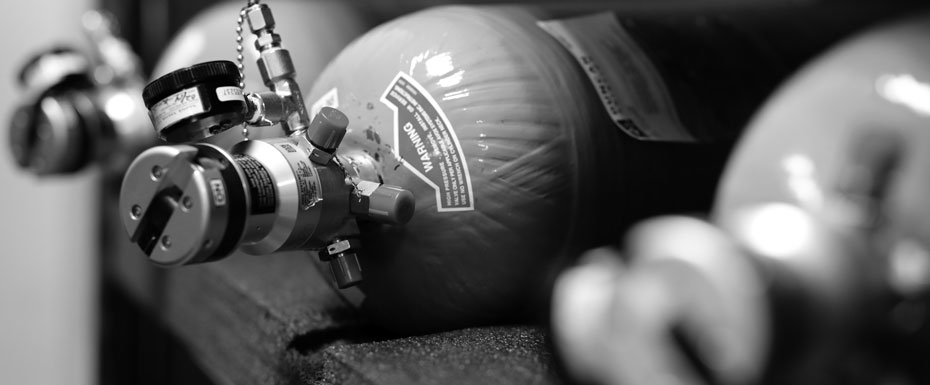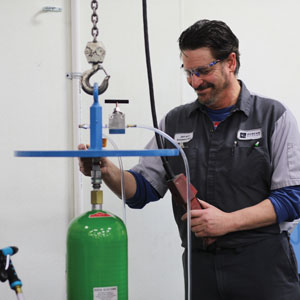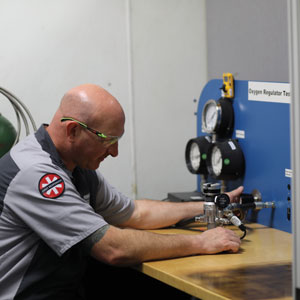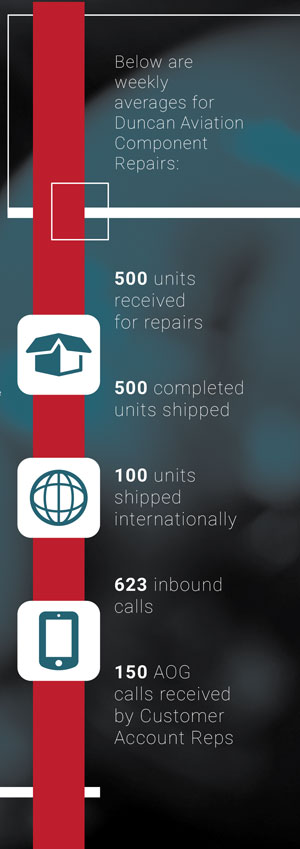
Every business aircraft has many pressurized vessels on board. These include oxygen bottles, portable fire extinguishers, emergency air bottles, and engine and APU fire extinguishers. All must be inspected and tested at specific intervals to ensure container strength and integrity.
In 2017, Duncan Aviation’s Accessories Department, led by Master Accessories Tech Jeff Witt, started down the path to becoming a certified hydrostatic facility. Admittedly, he said the process was not without its challenges. “One of the first hurdles we faced was identifying who is in charge.” It turns out the answer was not an easy one.

Jeff Witt, Master Accessories Tech
While Aircraft Chapter 5 requirements determine hydrostatic testing intervals, the associated FARs (Federal Aviation Regulations) fall under the jurisdiction of the DOT (Department of Transportation) and the Compressed Gas Association. Together, they govern the requirements, testing methods, and certification of qualified facilities.
Also, the PHMSA (Pipeline and Hazardous Materials Safety Administration) regulates the licensing of companies that perform cylinder inspections on the composite-wrapped oxygen bottles found on 90% of all aircraft. And the NFPA (National Fire Protection Association) maintains certification and testing oversight of portable fire extinguishers.
Requirements for all of these agencies had to be met or surpassed before Duncan Aviation could obtain hydrostatic certification.

Jerry Cable, Duncan Aviation Accessories Tech Rep, explains the basic principle behind hydrostatic testing is a relatively simple one. “The cylinder is filled with water, placed in a water jacket, and pressurized to the required test pressure. Under this pressure, the cylinder expands and displaces a small amount of water from the water jacket. The volume of the water expelled is measured. Once the pressure is released, the vessel contracts to nearly the same size as it started. The water previously discharged is drawn back into the water jacket and a second measurement is taken.”
It is these measurements that must meet Component Maintenance Manual criteria to ensure the vessel is structurally sound. Jerry adds that the hydrostatic testing of pressurized bottles is quite safe. “If during testing there is a catastrophic failure, the failure is not catastrophic at all. The water jacket merely expels the excess water, and the technician’s shoes get wet.”
“We are in business with brand new certified equipment including a water jacket, bottle dryer, control unit and pumps, pneumatic bottle vise, calibrated cylinders, and a Halon-reclamation system.”
-Jeff Witt, Master Accessories Tech

It took more than a year of research, training, and agency consultations, but Jeff says the effort was worth it when the Duncan Aviation hydrostatic testing lab was completed. “We are in business with brand new certified equipment including a water jacket, bottle dryer, control unit and pumps, pneumatic bottle vise, calibrated cylinders, and a Halon-reclamation system.” All six of Duncan Aviation’s qualified technicians are factory-trained as hydrostatic instructors.
At the same time, new oxygen bottle repair and test stand procedures were written and built to remove and overhaul oxygen bottle regulators. Most operators choose to have these overhauled at the same time hydrostatic testing is performed.
Because workplace safety is paramount in all circumstances, the water jacket is permanently installed in a 3-foot, concrete pit in the shop floor, eliminating having to hoist the pressure bottle and lid assemblies, which can weigh as much as 300 pounds, above the heads of the technicians when the assemblies are lowered into the water jacket.
A clean room environment located adjacent to the shop is used to perform maintenance on oxygen cylinders and regulators as needed. Additionally, the area is used to store Halon, a hazardous liquid present in portable fire extinguishers and engine/APU fire extinguishers. The reclamation system removes the Halon from the bottles and safely stores it until it can be placed back in the bottles after testing. The room is equipped with alarms in the unlikely event of a tank rupture or leak.
The Duncan Aviation Accessories Department currently supports the hydrostatic needs of all in-house customers at our three MRO facilities in Battle Creek, Michigan; Lincoln, Nebraska; and Provo, Utah.
Now that the word is out that Duncan Aviation is a certified hydrostatic testing facility, we have signed several service contracts and a dedicated hydrostatic technician has joined the team to meet growing customer demand.